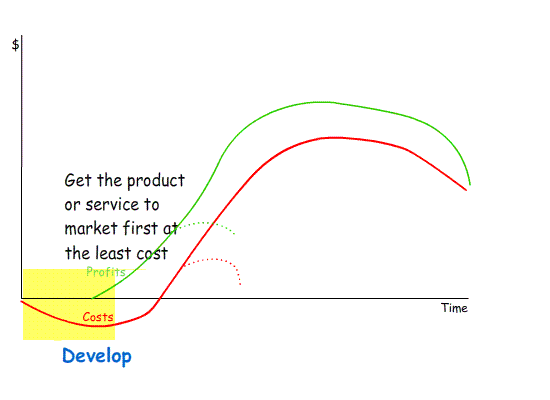Bottom-up
Overview
Bottom-up planners and entrepreneurs jump at the opportunity. The adapt quickly to changes in the market. Often the future is not clear, but the pressure to hang on the past
successes, so strong in people, causes us wait too long to change when
you need to
respond. We admire entrepreneurs who understand that opportunity and
go after it. It is harder inside an established firm.

Use a bottom-up approach when your business needs to be more innovative. Rather than waiting for corporate guidance, bring ideas forward.
Make it part of your culture - asking your best folks and your youngsters
to show you what you should be doing. My experience is most companies
want to do that. It's politics that make it difficult.
When products or services' margins hint troubles ahead and innovation
is not a strength, very dedicated folks inside your business will work
against
the grain. They'll try to find new ways to reach your customers. Called
change agents or corporate rebels, they have to be shrewd to bring their
ideas to market or to get the business model to evolve. This is the hardest
process to make succeed. I was twice successful as a change agent and
failed once. Gary Hammel described the process in detail in Leading the Revolution. Unfortuantely, Enron was his prime example — there are risks of over-confidence.
Why it is hard
A bottom-up approach can be messy. Ideas, reputations, egos and tight
budgets compete. In large bureaucratic organizations, add lack of inertia,
too many decision makers and turnover to the mix. Stir in the inevitable
failures. It is stressful. The folks that develop the strategies often
feel danger comes not from competitors without, but from turf protectors
within.
Yet, every CEO I've spoken to privately said "innovation is the
key to future successes." Every single one! And, they understand
the value of stretching the organization. Its just they are CEOs and know
publicly chasing every new idea can be very disruptive. The idea has to
prove itself before the CEO tells everyone to change direction. They know
that most of their employees are doers who need continuity. Constant change
takes away the doers' greatest advantage, learning to do a job better.
To make bottom-up innovation part the culture, communicate a clear-cut
rules for innovators.
To work against the grain, seek out the organization's future leaders
and form a coalition.
To skip ahead, go to the Meetings Chapter
on bottom-up and entreprenuers.
Bottom-up Starts with Informal Teams (Coalitions)
When you get the idea, talk about it with innovative customers and validate
its worth.
Seek out other innovators in your company to talk it through, to refine the idea and
to provide you with political cover. Take your time here. Give folks time
to consider the idea.

Create a simple demonstration, from existing budgets, that can present
the idea in less than 15 minutes. It has got to be clear, concise, and
simple. Pick a "change agent" to present the idea, a very good communicator.
With the other team members, determine how to fund it: existing budgets,
debt, with a customer's help. The most challenging question you will be
asked is "what's it going to cost?"
When the timing is right, seek out the decision maker privately; give
the demonstration; lay out the business model; and address timing issues.
Ask for funding for a public demonstration. If needed, set up a three
person steering group just below the decision maker. Let them broaden
the coalition.
All great ideas have timing issues. Validate the concept through the
public demonstration when the time is right, and if it works, go for
it.
We'll discuss how to do this in the Meetings
chapter.
Steps -- Rules for bottom-up innovation
 Organize to make experimentation cheaper. For example, use technology
to think it through, learn the issues and demonstrate the concepts (from
a simple Excel spread sheet to complex simulators or decision models
like Expert Choice™, which I'll discuss in more detail in a future
chapter on software tools.) Organize to make experimentation cheaper. For example, use technology
to think it through, learn the issues and demonstrate the concepts (from
a simple Excel spread sheet to complex simulators or decision models
like Expert Choice™, which I'll discuss in more detail in a future
chapter on software tools.)
Budget for rapid experimentation, ensure key players can dedicate some
of their time to it and insist that the experiments had a clear link to
your current technologies or customer bond.
Have
a small oversight committee that manages the experimentation budget and
works to have efforts work in parallel rather than sequentially.
 Do simple demonstrations with customer involvement. Do simple demonstrations with customer involvement.
Abandon losers quickly, when a pre-determined spending cap is reached.
Reward cost-effective experimentation, even failures, and reward successful
experiments.
 Scenarios
Scenarios
|
|
Classic Team Planning

|
|